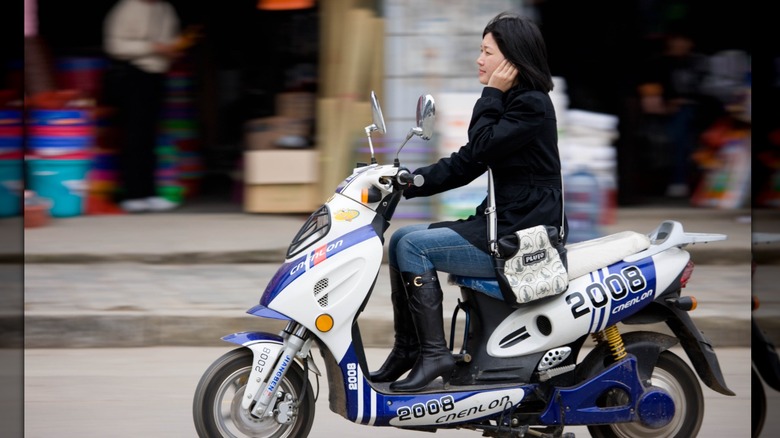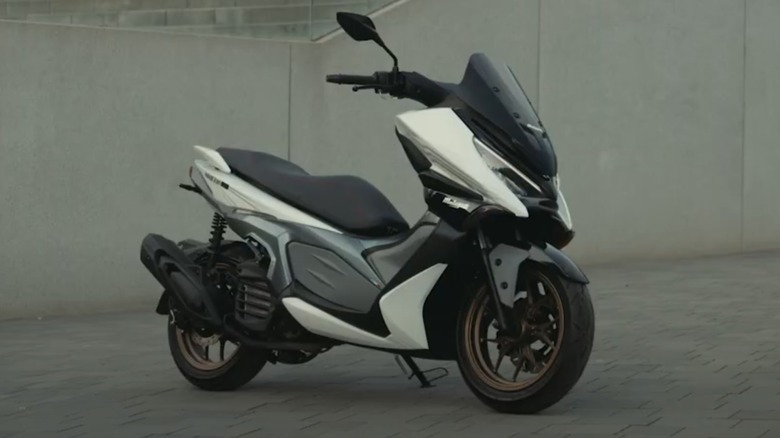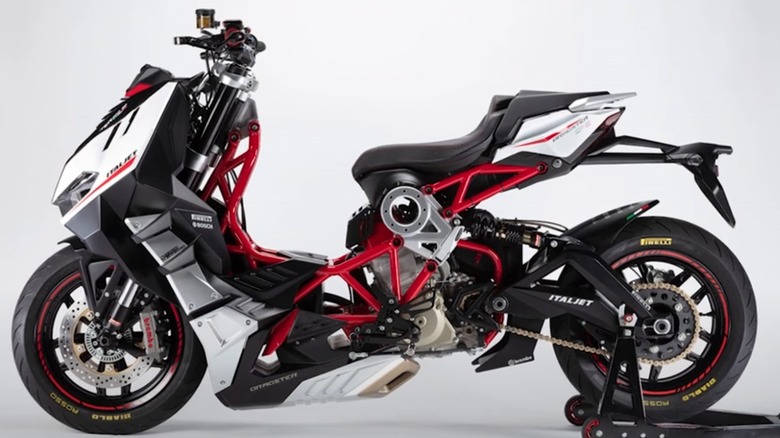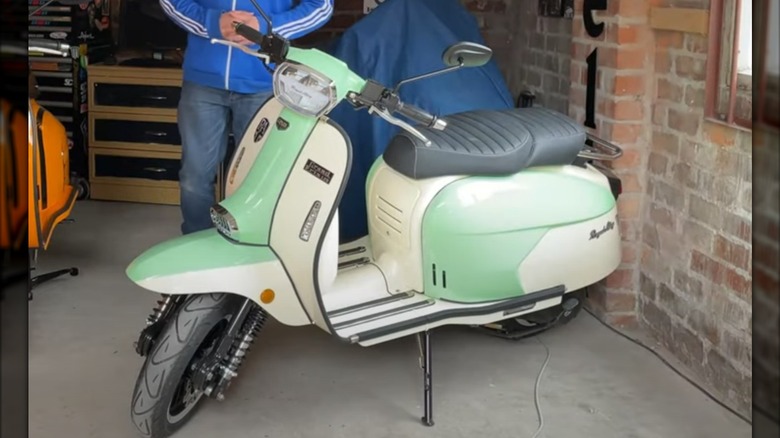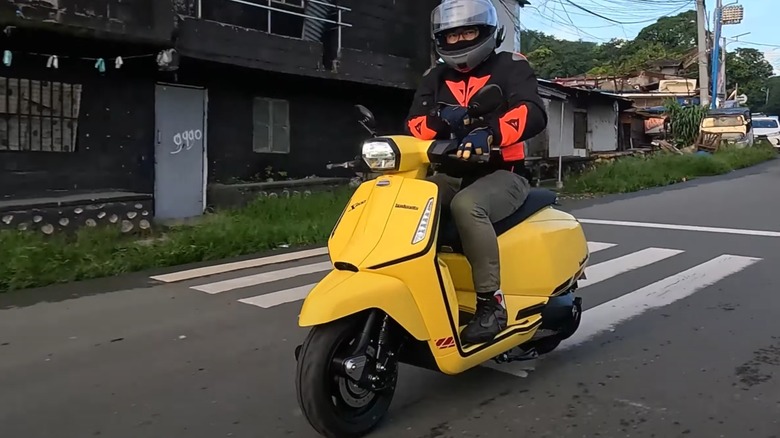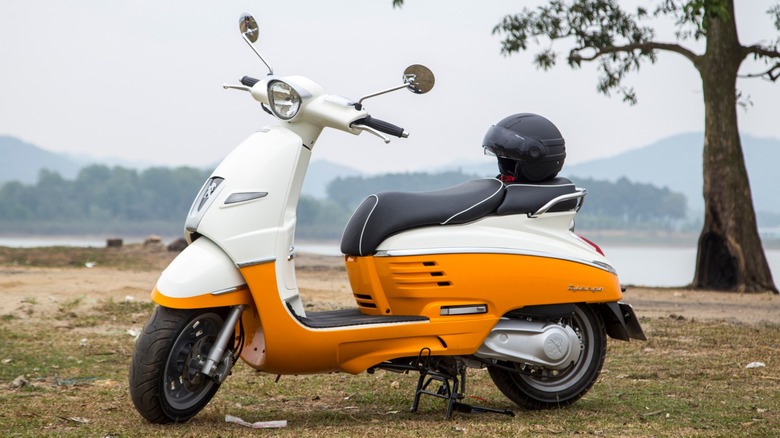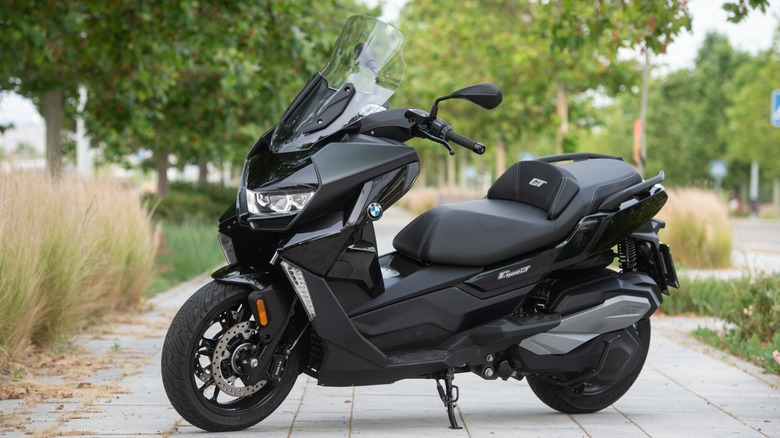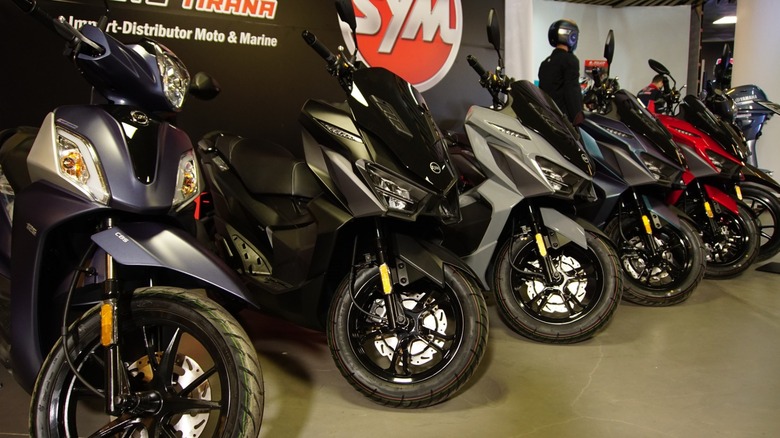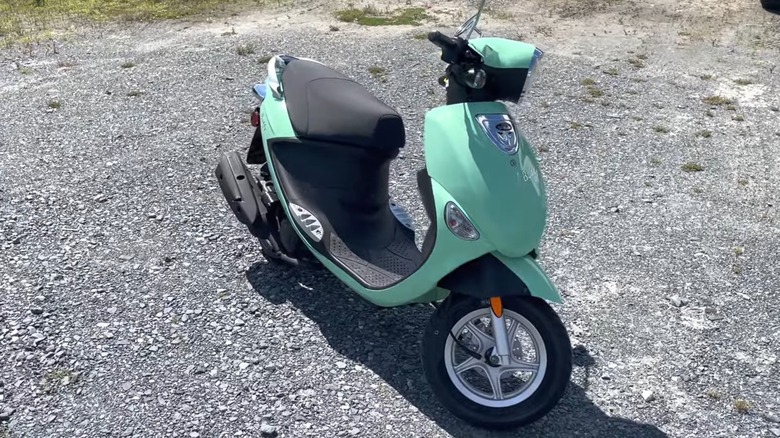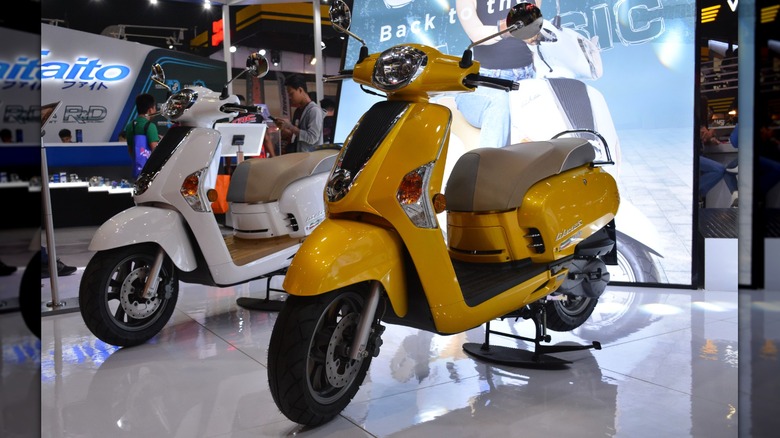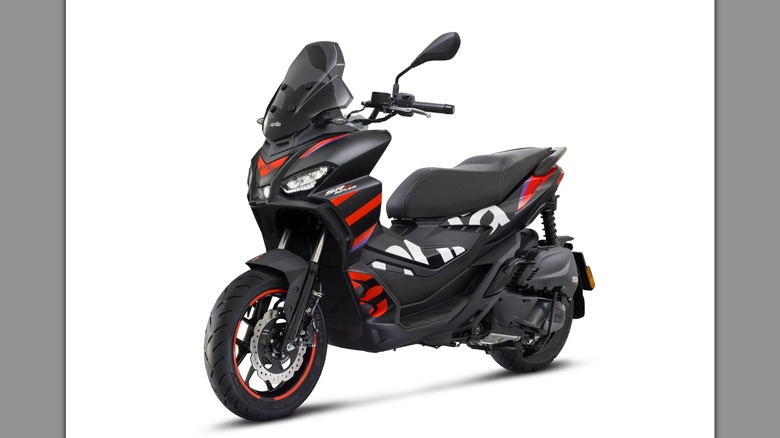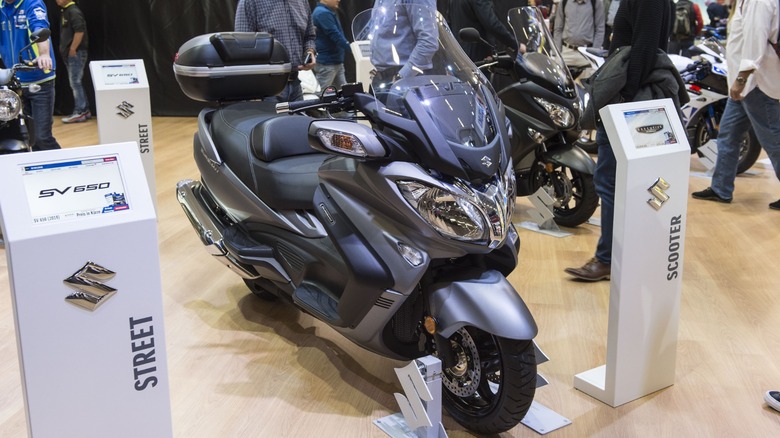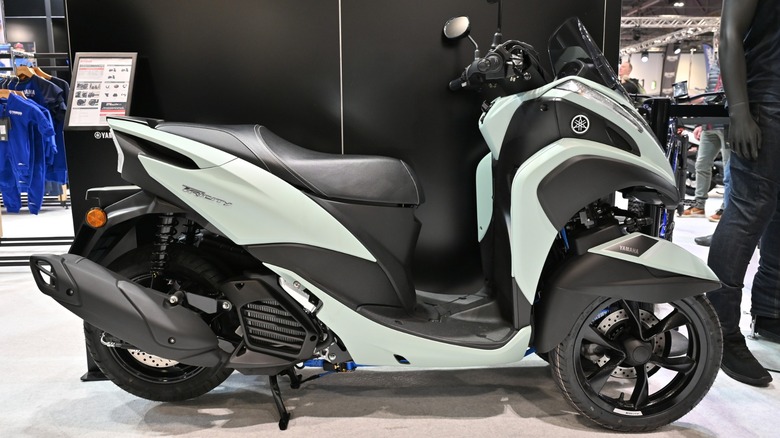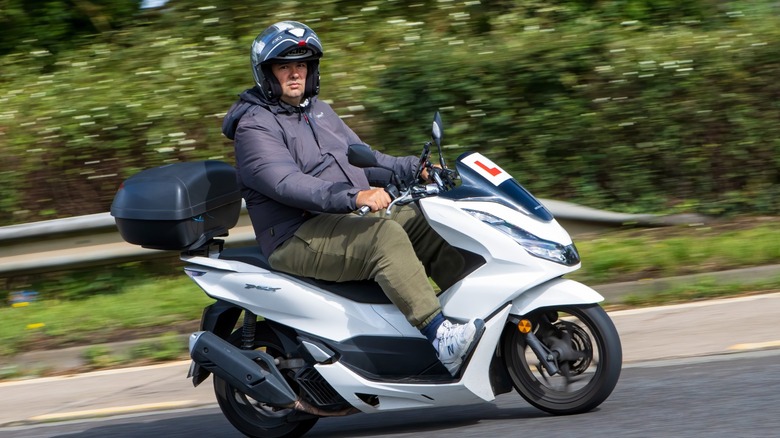Every Major Motor Scooter Brand Ranked Worst To Best
For well over a century, people have used motor scooters as both cheap and convenient transportation as well as for leisure. But in post-war Italy, inspired by American soldiers riding Cushmans, Enrico Piaggio developed the Vespa, creating an icon of style and mobility popular worldwide.
The step-through design with the engine tucked away underneath and legs protected behind a shield is now ubiquitous across the industry, and has proliferated to a wide array of styles and classes of scooter that follow this basic design. Notably, this is different from a moped, which is essentially a bicycle with pedals and an integrated engine, although the term moped is often misattributed to scooters. Nonetheless, scooters today offer convenience and economy along with carefree fun on two wheels.
I first rode a Puch moped when I was about 12 years old before getting my first dirt bike a year later, leading to a lifetime of riding two-wheelers. I have owned scooters for about 20 years, and my first scooter purchase led me to become the general manager for a scooter dealer for a couple of years. I am also a trained auto tech and have professionally worked on many scooters. All this is to say that I know motor scooters pretty well and have first-hand experience with a wide range of them. Therefore, applying my experience, I present to you this list of major motor scooter manufacturers — gas-powered only –- ranked from the worst to the best.
Rebranded Chinese models
Chances are, you have encountered one of these rebranded Chinese scooters. They are sometimes sold alongside furniture or tools and might feel like an afterthought or a neglected side hustle. However, others are sold next to mainline brands in scooter shops or large motorcycle dealers and represent a considerable bargain. If you have never heard of the brand, such as the oddly-named Icebear, it likely comes from China.
These are bought from Chinese manufacturers by distributors who sell them to dealers with their own branding. Some of these are decent, while others are of criminally poor quality. Parts can be near impossible to source and many motorcycle shops will refuse to service them. The better brands have full support with parts availability, warranty, and a dealer network, but it is the furniture store scooters that bring the others down. It is paramount to research before buying one of these, or save a bit and go for a known brand.
Malaguti
A historic Italian brand selling a range of often stylish motorcycles and scooters, Malaguti has been producing two-wheelers in Italy for more than a century. Although it once produced up to 30 models, it never attained widespread recognition, although it created some attractive products, such as its Saigon 50cc scooter of the 1960s and its retro Yesterday from 1997. However, production finally ceased around 2011.
Now manufactured by Piaggio Zongshen Foshan as an OEM under the KSR Group of Austria, Malaguti falls into the category of established brand utilizing Chinese production to achieve a balance between quality and value. Quality can be expected to be good, considerably exceeding that of rebranded Chinese models, and the current lineup also appears to have attractive modern styling with the latest features.
Italjet
Italjet emerged in the 1960s, building bikes under its own name as well as supplying machines for rebranding — Indian Motorcycles was a customer at one time. Many models were small and basic, but Italjet did make a few into the 500cc to 750cc range. Of Italjet models, the most peculiar and interesting is its Dragster. Introduced around 2000, it featured a wild design on a trellis frame with a unique hub-centric front suspension and centrally mounted shock absorber. Italjet also offered it with a 2-stroke 180cc water-cooled engine, making it a real screamer.
Now, Italjet is back with only a single model, the Dragster again. Equipped with a modern 4-stroke engine and fuel injection, the unique frame and suspension remain, along with displacement up to 300cc. Even more exciting is the bonkers 700 Twin, the world's first superscooter. Limited production keeps Italjet from moving into a higher-tier manufacturer. Personally, I want one of each, no matter how impractical any may be.
Royal Alloy
Reproducing icons of the past is a popular trend and can prove to be a profitable venture. Just look at the success of the VW Beetle, Mini Cooper, and the Dodge Challenger in building new models that look like retro classics. It should be no surprise that this works with scooters as well. Newcomer Royal Alloy has brought an icon of the '60s back as an almost mirror image of the original.
For those who love the Lambretta scooters of the 1960s but cannot afford an expensive restored copy, Royal Alloy has the answer in a range of scooters built to look like exact replicas. Built with modern automatic 4-stroke engines, they lovingly recreate the styles of the old scooters while providing a thoroughly modern riding experience. Royal Alloy is a British company building these with partners in China and Thailand, so you can expect quality to be above average. However, with only a handful of years in production, long-term durability is still an unknown quantity, but they do at least come with full factory support through local distributors.
Lambretta
A long-time rival to Vespa, the Lambretta by Innocenti proliferated in the '50s and '60s before the company folded. Although SIL in India continued building Lambrettas, it was under another name as the rights bounced around for many years before landing in Thailand, where new and modern versions of the Lambretta are built today.
The current Lambretta lineup includes three scooter models styled after the original but with a modern touch. The V, X, and G all offer fuel-injected 4-stroke liquid-cooled engines ranging from 125 to 330cc in size, along with the latest technology, including digital gauges, disc brakes, and LED lighting. Far more sophisticated than the historic models that inspired them, these models radiate style and are a fitting tribute. Thai partner GPX produces the engines, and quality appears to be top-notch.
Peugeot
Peugeot has been making motorcycles longer than anyone, having built its first model in 1898. Currently, the range includes engine sizes of 50 to 400cc, and all but one utilize the classic step-through design. Peugeot offers one three-wheeled bike with a pair of leaning front wheels like the Piaggio MP3 while the XP400 looks ready to tackle anything as a kind of adventure scooter with all-terrain tires and a tall ride height.
For those who want style, the Django model is dripping with it. It pulls off a retrotastic design flawlessly. Unfortunately, I have no experience with any of these as they do not sell in the States, but they appear to be premium machines. I could not find much info in English about long-term reliability and build quality except for a few random user comments that mention maintenance can be a bit pricey and more frequently required than on other bikes, but it gets plenty of bonus points for style.
BMW
BMW Motorrad's history of building motorcycles stretches back to 1923, and it has been delivering unique and innovative bikes ever since. However, scooters were never a consideration until the release of the C1 scooter in 2000. It was an interesting bike with a full roll cage and a seat belt – it did not catch on.
Now, BMW offers three scooters, of which only one uses gasoline. The C 400 GT is a sizable maxi-scooter with a fuel-injected 350cc engine and plenty of sophisticated equipment. Tech-heavy features include ABS, traction control, keyless ignition, full color screen, and electronic throttle-by-wire. Otherwise, it has typical BMW fit and finish, and its comfort is spot on, something many scooters lack. With only one pricey comparable model, BMW is hard to rank at the top, but the name alone should explain why it is not too far from it.
SYM/Lance
Scooters are extremely popular in Taiwan, where one scooter is owned by every 1.8 residents of the island. This is the world's highest density of scooters, and, as a result, Taiwan's scooter manufacturers are among the best.
SYM is one of the biggest scooter manufacturers in Taiwan, producing nearly 30 models from 50 to 500cc. Additionally, on these bikes, you will find cutting-edge technology and electronics complemented by attractive styling and good ergonomics. Highlights include the highway-capable twin-cylinder DOHC Maxsym TL 508 maxi-scooter and stylish Fiddle 50 for cruising urban centers.
I have some experience with SYM models, and they have excellent build quality and offer TFT digital screens, fuel injection, and ABS on many models. I recommend them as a more affordable option to Japanese models, as they will be equally durable and reliable but at a lower price point. They are also sold under the Lance name in the United States.
Genuine Scooter Company
Genuine Scooter Company models were among the best sellers for me during my time managing Tulsa Scooters. Initially, the only model offered was a fashionable Indian-built Vespa PX clone called Stella. However, a short time later, Genuine expanded its offerings by bringing in a new model from Taiwanese partner PGO. This went well for Genuine as supplies of the Stella later dried up.
The new Buddy 125 became an instant hit thanks to having modern mechanics paired with hip colors and stylish accessories. Best of all, build quality and reliability were both excellent and remain so today. Genuine now offers seven PGO models alongside others sourced elsewhere. I don't recall ever submitting a warranty claim for a Buddy, and I liked the scooter enough to have bought one last year. Sitting for years, it only needed a battery to rejoin the road. If you like the style, don't hesitate to get yourself a Buddy.
Kymco
The largest scooter manufacturer in Taiwan began as a parts supplier for Honda, eventually breaking off and building its own models. Kymco now produces a wide range of scooters and ATVs, building up to 600,000 units per year. Key to Kymco's success is quality control and producing predictably reliable machines year after year.
I sold Kymco scooters and have ridden many of them, including a People 150 that I kept and rode daily for about two years. Never once did it fail to start, and it always felt tight and put together, with good acceleration and excellent handling. The fit and finish of a Kymco is equal to anything from Europe or Japan, but benefits from lower manufacturing costs. This means they are cheaper than comparable Japanese models without sacrificing quality. Furthermore, with a wide range of models from 50 to 550cc, there is something for everyone.
Aprilia
For those who want Italian style and all-out speed, the Aprilia RSV4 is a great choice thanks to its sophisticated 217-horsepower V4. But for those of us content with more modest speeds but still appreciate Aprilia's aggressive style, there are a few scooter options available.
Scooters have been part of the mix for years. While its first scooter, the 1990 Amico, was simple and basic, later models have demonstrated Aprilia's capability to create cutting-edge models with excellent performance. The lineup currently includes 50, 125, and 200cc models that all forgo all tendencies toward heritage and lean heavily into the modern. With features such as fuel injection and water cooling, Aprilia scooters perform at the top of their respective classes.
Suzuki
Part of Japan's Big Three, Suzuki is known worldwide for rugged and reliable products like the
Suzuki Samurai micro Jeep from the 1980s
. In the United States, scooters have never been a big part of its business, offering only larger maxi-scooters suitable for the wide open spaces and miles of tarmac available. That is not necessarily the case elsewhere.
Only the Burgman is offered in America, and you can choose between a 200 or 400cc engine. Unfortunately, Suzuki discontinued its excellent 650cc Burgman, which featured a twin-cylinder engine that was essentially half of a Hayabusa 4-cylinder with speeds over 100 mph. In other markets, Suzuki offers a small range of scooters mostly in the 125cc range and of conventional styling, although the Saluto 125 is a beautifully designed exception.
Yamaha
Yamaha has been building good scooters for decades. Its first foray into scooters happened in 1960 but was short-lived. The second attempt came in 1977 when Yamaha attempted to get ladies riding the compact Passol, and it has been at it ever since, producing three or four models to complement its motorcycles.
Currently, only two Yamaha scooters are offered in the States, but around the world, buyers can choose from a few other bikes ranging in size from 125cc up to the advanced 560cc Tmax Tech Max. Expect from Yamaha an incredibly well-built machine equipped with the best technology and plenty of innovative engineering. Styling can be middling on some models while others are quite attractive, but don't expect to see the latest European trends on a Yamaha.
Honda
The world's biggest motorcycle manufacturer really needs no introduction. Honda has dominated the two-wheeled transport space for nearly 75 years, and it has accomplished that by making motorcycles with an impeccable reputation for reliability. Furthermore, Honda does not rest on its laurels and sets the bar high for innovation and design.
However, Honda's first two scooters, the Juno K and Juno M, failed to get a foothold. Scooters returned sometime in the '80s — the Elite 250 remains one of my favorite scooters of all time — and have all retained the same affordable quality Honda is known for. Furthermore, in my experience, Honda makes products that are easy to service and are assembled with some logic to them. You really cannot go wrong buying any Honda.
Vespa
While Enrico Piaggio is often erroneously credited with creating the motor scooter, he may have created the first scooter with style. With famous appearances in films like "Roman Holiday" and the Who's scooter hooligan inspired "Quadrophenia," the Vespa has become part of the wider culture to the point that it has become the generic term for scooter to many.
The Vespa continues to thrive to this day. Its modern offerings continue to be of high quality, featuring the latest tech and advanced engineering. But most importantly, the Vespa's Italian styling sets it apart. Retro-styled scooters from other manufacturers often, if not always, trace the roots of their design to a Vespa indirectly — that is, if they are not an exact copy.
Every time I ride a Vespa, I am struck by how well put together and balanced they feel. This all comes at a premium, as nobody can claim they are cheap. But if your ride's good looks are as important as its build quality, there really is no other choice.

